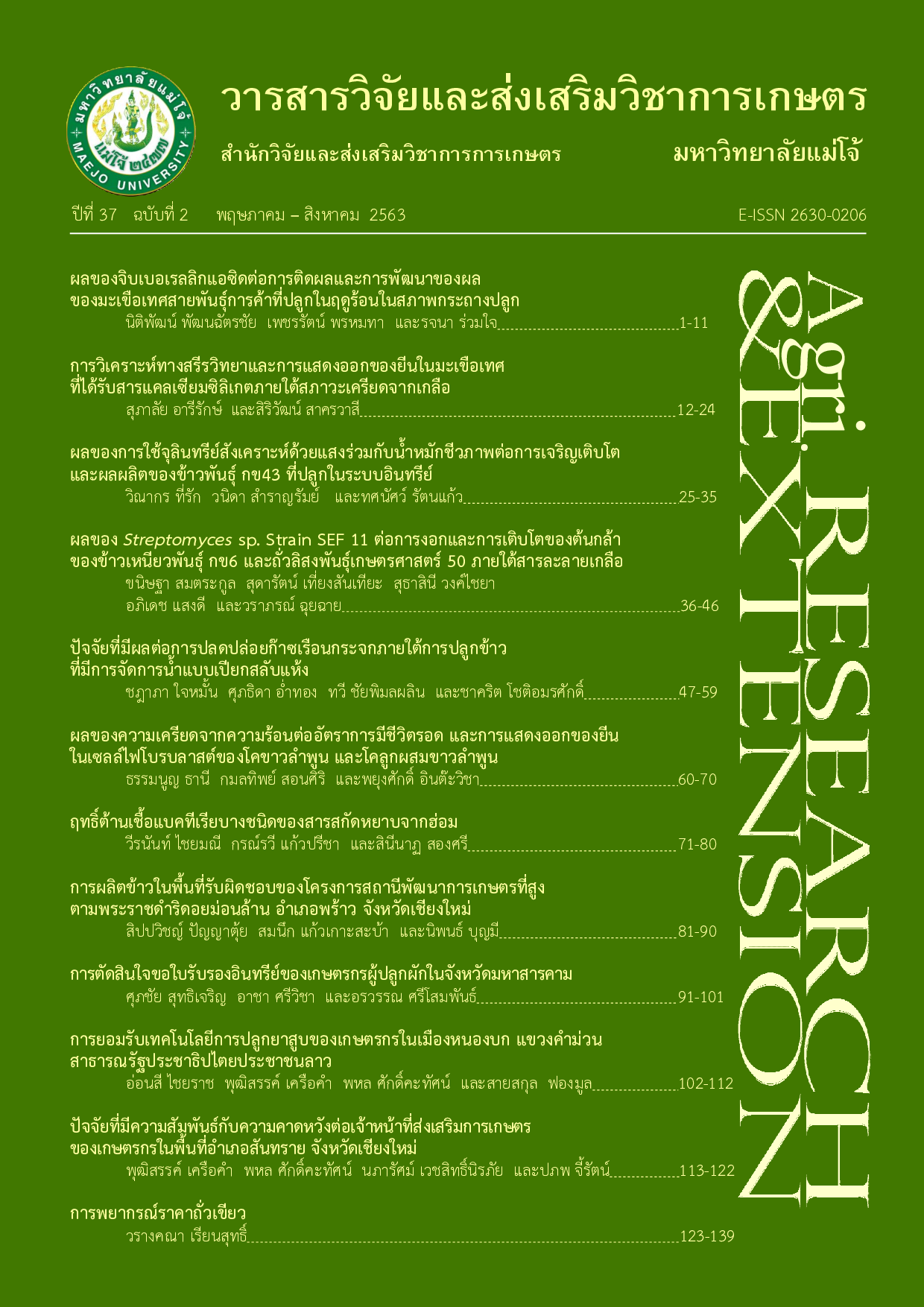ผลของความเครียดจากความร้อนต่ออัตราการมีชีวิตรอด และการแสดงออกของยีน ในเซลล์ไฟโบรบลาสต์ของโคขาวลำพูน และโคลูกผสมขาวลำพูน
คำสำคัญ:
การแสดงออกของยีน, อุณหภูมิร้อน, เซลล์ไฟโบรบลาสต์, โคลูกผสม, โคขาวลำพูนบทคัดย่อ
การศึกษานี้มีจุดประสงค์เพื่อตรวจสอบอัตราการมีชีวิตรอด และการแสดงออกของยีนในเซลล์ไฟโบรบลาสต์โคขาวลำพูน โคลูกผสมขาวลำพูน-แองกัส และโคลูกผสมขาวลำพูน-ชาร์โรเล่ส์ ภายใต้อุณหภูมิร้อน เซลล์ไฟโบรบลาสต์ถูกเก็บจากชิ้นเนื้อใบหูของโคเพศเมีย จำนวน 9 ตัว จากนั้นทำการเพาะเลี้ยงที่อุณหภูมิ 38.5°ซ.
การศึกษาที่ 1 ศึกษาอัตราการมีชีวิตรอดของเซลล์ไฟโบรบลาสต์หลังจากได้รับความร้อนที่อุณหภูมิ 42 °ซ.เป็นเวลา 6, 24 และ 48 ชั่วโมง กลุ่มโคขาวลำพูน (n=3) มีอัตราการรอดชีวิตร้อยละ 99.59, 98.73 และ 92.88 ตามลำดับ สูงกว่าโคลูกผสมขาวลำพูน-แองกัส (n=3) ร้อยละ 98.73, 95.70 และ 88.61 ตามลำดับ และโคลูกผสม ขาวลำพูน-ชาร์โรเล่ส์ (n=3) ร้อยละ 99.53, 96.36 และ 88.85 ตามลำดับ แตกต่างอย่างมีนัยสำคัญทางสถิติ (P<0.05) สหสัมพันธ์ระหว่างระยะเวลาได้รับความร้อนกับอัตราการมีชีวิตรอด พบว่ากลุ่มโคลูกผสม ทั้ง 3 พันธุ์ หลังจากฮีทช็อคมีความสัมพันธ์กันในทิศทางเชิงบวก โคขาวลำพูน เท่ากับ 0.896 โคลูกผสมขาวลำพูน-แองกัส เท่ากับ 0.647 และ โคลูกผสมขาวลำพูน-ชาร์โรเล่ส์ เท่ากับ 0.862 ตามลำดับ
การศึกษาที่ 2 การแสดงออกของยีนที่เกี่ยวข้องกับการปรับตัวให้ทนร้อนของเซลล์ภายใต้อุณหภูมิร้อน Bcl-2, HSP90 และ HSP70 ด้วยเทคนิค Reverse-Transcription Polymerase Chain Reaction (RT-PCR) เซลล์ไฟโบรบลาสต์หลังจากฮีทช็อคที่อุณหภูมิ 42°ซ. เป็นเวลา 6, 12 และ 24 ชั่วโมง ถูกนำมาสกัด total RNA แล้วนำ total RNA ที่ได้มาเปลี่ยนเป็น cDNA และทำการเพิ่มปริมาณยีน Bcl-2, HSP90 และ HSP70 และยีน β-actin ถูกใช้เป็นยีนกลุ่มควบคุม พบว่าเซลล์ไฟโบรบลาสต์ทุกกลุ่มมีการแสดงออกของยีน Bcl-2, HSP90 และ HSP70 หลังจากได้รับความร้อน สรุปว่าเซลล์ไฟโบรบลาสต์ของโคพื้นเมืองขาวลำพูน ภายใต้อุณหภูมิร้อนที่ 42°ซ. มีอัตราการมีชีวิตรอดของเซลล์สูงกว่าโคลูกผสม และเซลล์มีการแสดงออกของยีนที่เกี่ยวข้องกับกระบวนการปรับตัวให้ทนต่อความร้อนที่เพิ่มขึ้น ซึ่งจะช่วยให้โคเนื้อพันธุ์พื้นเมืองและลูกผสมพื้นเมืองสามารถปรับตัวเข้ากับสภาพในเขตร้อนชื้นของประเทศไทยได้
เอกสารอ้างอิง
Basirico, L., P. Morera, V. Primi, N. Lacetera, A. Nardone and U. Bernabucci. 2011. Cellular thermotolerance is associated with heat shock protein 70.1 genetic polymorphisms in Holstein lactating cows. Cell Stress Chaperones 16(4): 441-448.
Bhanuprakash, V., U. Singh, G. Sengar, B. Sajjanar, B. Bhusan, T.V. Raja, R. Alex, S. Kumar, R. Singh, A. Kumar and R.R. Alyethodi. 2016. Differential effect of thermal stress on Hsp70 expression, nitric oxide production and cell proliferation among native and crossbred dairy cattle. J. Therm Biol. 59: 18-25.
Collier, R.J., G.E. Dahl and M.J. VanBaale. 2006. Major advances associated with environmental effects on dairy cattle. J. Dairy Sci. 89(4): 1244-1253.
Colmont, C., S. Michelet, D. Guivarch and G. Rousselet. 2001. Urea sensitizes mIMCD3 cells to heat shock-induced apoptosis: protection by NaCl. Am. J. Physiol Cell Physiol 280(3): 614-620.
Dalgaard, P. 2002. Introductory Statistics with R. New York: Springer. 364 p.
De Thonel, A. and J.E. Eriksson. 2005. Regilation of death receptors-relevance in cancer therapies. Toxicol Appl Pharmacol. 207(2): 123-132.
Deb, R., B. Sajjanar, U. Singh, S. Kumar, R. Singh, G. Sengar and A. Sharma. 2014. Effect of heat stress on the expression profile of Hsp90 among Sahiwal (Bos indicus) and Frieswal (Bos indicus × Bos taurus) breed of cattle: A comparative study. Gene 536(2): 435-440.
Dobson, H. and R.F. Smith. 2000. What is stress and how does it affect reproduction. Anim. Reprod Sci. 61: 743-752.
Doljanski, F. 2004. The sculpturing role of fibroblast-like cells in morphogenesis. Perspect. Biol. Med. 47(3): 339-356.
Hu, W. and J.J. Kavanagh. 2003. Anticancer therapy targeting the apoptotic pathway. Lancet Oncology 4(12): 721-729.
Intawicha, P., Y.W. Ou, N.W. Lo, S.C. Zhang, Y.Z. Chen, T.A. Lin, H.L. Su, H.F. Guu, M.J. Chen, K.H. Lee, Y.T. Chiu and J.C. Ju. 2009. Characterization of embryonic stem cell lines derived from New Zealand white rabbit embryos. Cloning Stem Cells 11(1): 27-38.
Koatdoke, U., S. Katawatin, S. Srimaraks, M. Duangiinda and Y. Phasuk. 2006. Comparative study of physiological responses related with thermotolerance between Bos indicus and Bos taurus. Khon Kaen Agriculture Journal 34(4): 347-354. [in Thai]
Lee, J.W., H. Li, H.Y. Wu, S.S. Liu and P.C. Shen. 2016. Improved cellular thermotolerance in cloned Holstein cattle derived with cytoplasts from a thermotolerant breed. Theriogenology 85(4): 709-717.
Lerdweeraphon, W. 2017. The roles of heat shock proteins 70 in enhancing the productive performances of livestock animals. Chiang mai Veterinary Journal 15(1): 1-14. [in Thai]
Maloney, A. and P. Workman. 2002. Hsp90 as a new therapeutic target for cancer therapy: the story unfolds. Expert. Opin. Biol. Ther. 2(1): 3-24.
Neckers, L. 2002. Hsp90 inhibitors as novel cancer chemotherapeutic agents. Trends Mol. Med. 8(4 Suppl): S55-61.
Neckers, L., E. Mimnaugh and T.W. Schulte. 1999. Hsp90 as an anti-cancer target. Drug. Resist. Updat. 2(3): 165-172.
Prayong, P., N. Weerapreeyakul and S. Barusrux. 2007. Apoptosis: pathway and assay. Journal of Health Research21(3): 227-238. [in Thai]
Singh, A.K., R.C. Upadhyay, D. Malakar, S. Kumar and S.V. Singh. 2014. Effect of thermal stress on HSP70 expression in dermal fibroblast of zebu (Tharparkar) and crossbred (Karan-Fries) cattle. J. Therm. Biol. 43: 46-53.
Vogel, P., E. Dux and C. Wiessner. 1997. Evidence of apoptosis in primary neuronal cultures after heat shock. Brain Research 764(1): 205-213.
Wolfenson, D., Z. Roth and R. Meidan. 2000. Impaired reproduction in heat stressed cattle: basic and applied aspects. Anim Reprod Sci. 60-61: 535-547.
Wu, H.Y., S.Y. Peng, H. Li, J.W. Lee, P. Kesorn, H.H. Wu, J.C. Ju and P.C. Shen. 2017. Ear fibroblasts derived from Taiwan yellow cattle are more heat resistant than those from Hostein cattle. J. Therm. Biol. 66: 56-62.
ดาวน์โหลด
เผยแพร่แล้ว
รูปแบบการอ้างอิง
ฉบับ
ประเภทบทความ
สัญญาอนุญาต
ลิขสิทธิ์ (c) 2020 วารสารวิจัยและส่งเสริมวิชาการเกษตร

อนุญาตภายใต้เงื่อนไข Creative Commons Attribution-NonCommercial-NoDerivatives 4.0 International License.
บทความนี้ได้รับการเผยแพร่ภายใต้สัญญาอนุญาต Creative Commons Attribution-NonCommercial-NoDerivatives 4.0 International (CC BY-NC-ND 4.0) ซึ่งอนุญาตให้ผู้อื่นสามารถแชร์บทความได้โดยให้เครดิตผู้เขียนและห้ามนำไปใช้เพื่อการค้าหรือดัดแปลง หากต้องการใช้งานซ้ำในลักษณะอื่น ๆ หรือการเผยแพร่ซ้ำ จำเป็นต้องได้รับอนุญาตจากวารสาร





